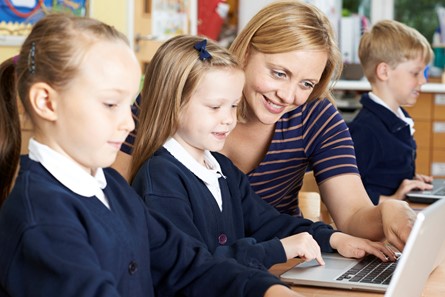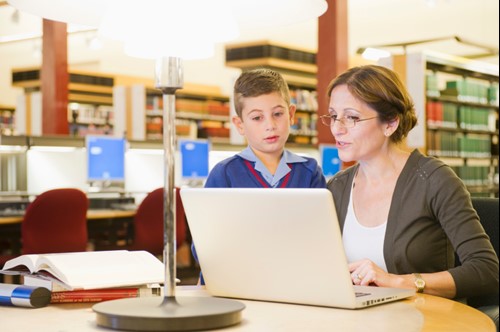Today, many countries such as Australia are continuing to place emphasis on the integration of ICT across the early childhood curriculum. From Early Childhood to Secondary education pedagogy and ICT across the curriculum together ensure that children are digitally equipped and are ICT capable for the future.
For this to occur, however, the foundations for strong technological pedagogical implementation must take place in Early Childhood and children must progress in their learning throughout primary education where the majority of learning progression as a result of good pedagogy and ICT across the curriculum resides.
So in this article, I will lay it out on the line for you in a detailed way that connects the best pedagogy that you can use for ICT across the curriculum. Much of this you will find in my online workshops for teachers using technology in the classroom.
First, let’s get to the bottom of this. What is ICT pedagogy and why is ICT pedagogy important? It is the effective integration of ICT alongside the early childhood curriculum. Simply its significance lies in the undeniable fact that children will need to live and work in an ICT dominated society. Integrating ICT across the curriculum in a meaningful context will mean that they will not only be able to use ICT to help achieve other learning outcomes that you will set for them but particularly as a primary teacher, you will be able to help develop their ICT capability using evidence based teaching strategies. The ICT pedagogy you will learn here ensures that you enable students to use ICT in such a way that it becomes sufficiently transparent that they hardly notice they are using it to achieve other learning outcomes.

Early Childhood Pedagogy with ICT across the EYLF
The use of pedagogy and ICT across the curriculum in this sector of education has developed and increased emphasis over the years. It is not crucial that you as an early childhood teacher, develop ICT capability in the ECE sector. In 2018, the Statement on Young Children and Digital Technologies pointed out the significance of evidence based pedagogy and ICT across the curriculum stating that “Young children have opportunities for
play and pedagogy in digital contexts.”
The development of ICT capability in early childhood education is due to the fact that like adults young children are taking technology for granted. It is a profound effect and it means that if they are to become proficient users of ICT that evidence based teaching strategies need to take place.
Ultimately, the other side of this equation is supporting you as a practitioner so that you will have a well-developed understanding of the role and potential of ICT for supporting young children’s learning. There are several paths (UNESCO, 2020) that you can go as an early childhood teacher in relation to pedagogy and ICT across the curriculum. However, the two paths that we offer you to focus on Integrating ICT in ECE and the Pedagogy of ICT.
So let’s delve into that now.
Formative Assessment in Early Childhood
When it comes to ensuring that pedagogy and ICT across the curriculum in the EYLF is effective it is essential that assessment for learning takes place right from the beginning. Young children as I have said enter your learning environment with varying degrees of ICT capability. It would be pointless to start planning for their technological literacy without establishing a starting point. It is about gathering and analysing the information about what they know, can do and understand.
According to the EYLF (2020), it is important for the following reasons for you as a teacher:
- Plan effectively for children’s current and future learning
- Communicate about children’s learning and progress
- Determine the extent to which all children are progressing toward realising learning outcomes and if not, what might be impeding their progress.
- Identify children who may need additional support in order to achieve particular learning outcomes, providing that support or assisting families to access specialist help
- Evaluate the effectiveness of learning opportunities, environments and experiences offered and the approaches taken to enable children’s learning
- Reflect on pedagogy that will suit this context and these children.
Essentially, effective methods of observation in early childhood education because that is part of your major expertise and as it is also the best way to assess a young child’s ICT capability, their capability to know how to use ICT for specific purposes. This can occur in your planned learning activities or when they are digitally playing especially in role play.
It from effective formative assessment in early childhood education you will lay the foundations to high impact teaching strategies in early childhood education in such a way that you will see learning progression take place with your own observations.
Across the EYLF outcomes
There are many opportunities to implement pedagogy and ICT across the curriculum. Here I will point out these in each of the learning outcomes in the EYLF.
EYLF Outcome 1 Children have a strong sense of identity:
ICT can enhance and support learning in many learning areas and this one is no exception. One of the areas of this child learning and development is in autonomy. Early childhood pedagogy to determine if a child is becoming autonomous with ICT is when you observe that the child:
- Decides when it is appropriate to use ICT
- Plans to use ICT techniques, software, or hardware
- Works independently to solve a problem.
- Evaluates their use of ICT.
All are attributes of higher order thinking skills.
Another part of this learning outcome is when “learn to interact in relation to others with care, empathy and respect”. The natural tendency of ICT to bring young children together to collaborate and cooperate is a wonderful opportunity to achieve this.
Early childhood pedagogy for you here would be in relation to several things. Firstly, digital play is one of the most important ways that a child can learn. Roleplay gives them the opportunity to make sense of the world and to reflect on the technological world in which they live. You can use open-ended questions to help them understand how technology works and why we use it. Consider the factors that will affect the quality of the role play such as how the children will be involved in setting up the role play area, their own life experiences and knowledge, and the quality and appropriateness of the resources.
Can you imagine the empathy, care, and respect the children will develop in this learning environment?
The way that you put them into groups will also impact on how they will develop these personal attributes. Think about their ICT capability, mix the sexes up and even use the approach where you signal change overs. This works particularly well when you are teaching new skills.
EYLF Outcome 2 Children are connected with and contribute to their world
The term ‘connection’ and ‘contribution’ speaks the loudest to me in terms of pedagogy and ICT across the curriculum in the early years. So what are some early childhood pedagogy to employ here?
Use ICT as much as you can to help young children connect to their communities, country, and people. You can achieve this with just one computer in the room. You can also use ICT to sense community within the learning environment with digital photos put up around the rooms.
Another idea would be to use the Internet to show and help young children learn about diversity. There are websites that also promotes engagement at different levels too. Websites about different languages can also be a great asset.

EYLF Outcome 3 Children have a strong sense of wellbeing
You can encourage the use of ICT for the documentation of their achievements and even use emails to share their successes with their families. Additionally, some children may need to be challenged to engage and persevere at ICT tasks and digital play.
As an early childhood teacher, you could build upon and extend their ideas with ICT when you do things such as:
- Clarifying ideas;
- Suggesting;
- Using encouragement to further thinking;
- Speculating;
- Re-capping;
- Respecting their decisions;
- Offering your own experiences.
In other words, when you are engaging in sustained shared thinking.
EYLF Outcome 4 Children are confident and involved learners
Technology is an excellent tool to model the inquiry process with. It is also a great learning tool in a learning environment where there is flexibility and open-ended.
Model the inquiry process and reflect with the children what they have learned during their ICT learning tasks or digital play.
Enable children to resource their own learning with various technologies and introduce appropriate ICT tools in early childhood. Ensure that they develop conceptual understanding in each of these tools and ICT techniques. Provide them with the ICT techniques and understanding to enhance their learning.
Facilitate their confidence in ICT that is available to them in your learning environment.
EYLF Outcome 5 Children are effective communicators
The use of ICT is prominent in this learning outcome. As an early childhood teacher, you need to provide access to ICT for young children so that they can have access information, investigate ideas and represent their thinking.
You need to plan for the integration of ICT across the curriculum and in play too. Throughout the EYLF it is essential that you develop their ICT capability by developing each component of it – routines, ICT techniques, conceptual understanding, processes, and higher order thinking skills.
Encourage collaborative learning about and through ICT integration between children and children and teachers.
The integration of ICT in early childhood pedagogy and curriculum is vital for the effective learning and development of children today. Effective pedagogy and ICT across the curriculum will mean that children are building their foundations of ICT capability, but are also prepared for a primary curriculum whose role is to further develop these capabilities.
To learn more about pedagogy and ICT across the curriculum in early childhood, visit this online workshop today.
Free Online PD For Early Childhood Educators - How to Integrate Technology in Preschool?

Integrating ICT in the Primary Curriculum
Developing student ICT capability across the curriculum requires your ability to make sound instructional decisions not only about whether it is appropriate to use ICT but how to ensure that the use of ICT continues remain transparent during ICT integration in meaningful and context-driven learning outcomes that you have set for your students.
Your choice of pedagogy across curriculum and ICT integration methods are important to every child’s use of ICT not just in early childhood education, but throughout primary education.
Here is what I consider the best pedagogy across curriculum and ICT integration in primary education.
Mathematics
The use of ICT pedagogy in this learning area can fall into two main categories – first, when you decide to just develop student ICT capability and second, when students use ICT as a tool for learning. I always encourage the latter. Why? It is very easy to achieve!
Many of the ICT tools and resources that I encourage involve the following attributes:
- Content-free and generic;
- Intellectually challenging for students;
- Give students full control over the technology itself and;
- Promote the development of higher order thinking skills because of the high level of decision making students have.